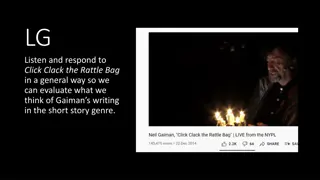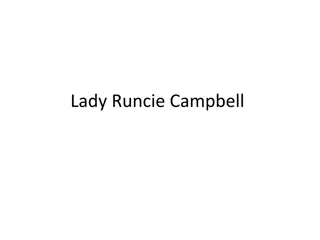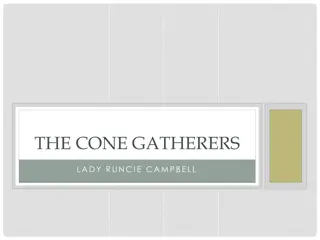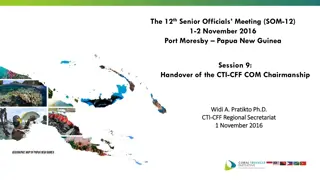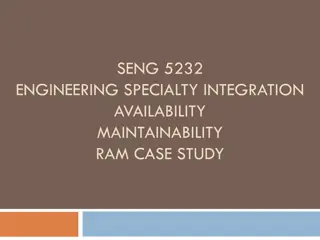Inherent Vice in Marine Insurance Policies
Exploring the concept of inherent vice in marine insurance, this content delves into the definitions, case studies, and implications of inherent vice on insurance coverage. Learn about the limits, exceptions, and tensions surrounding inherent vice in the context of marine insurance policies.
Uploaded on Dec 16, 2024 | 0 Views
Download Presentation

Please find below an Image/Link to download the presentation.
The content on the website is provided AS IS for your information and personal use only. It may not be sold, licensed, or shared on other websites without obtaining consent from the author.If you encounter any issues during the download, it is possible that the publisher has removed the file from their server.
You are allowed to download the files provided on this website for personal or commercial use, subject to the condition that they are used lawfully. All files are the property of their respective owners.
The content on the website is provided AS IS for your information and personal use only. It may not be sold, licensed, or shared on other websites without obtaining consent from the author.
E N D
Presentation Transcript
INHERENT VICE: LIMITS AND TENSIONS Neil Campbell QC Shortland Chambers, Auckland March 2017
Inherent vice - introduction Marine insurance concept. But most non-marine policies have exceptions that have a similar rationale.
Inherent vice in marine insurance Marine Insurance Act 1908, s 55(2)(c): Unless the policy otherwise provides, the insurer is not liable for ordinary wear and tear, ordinary leakage and breakage, inherent vice or nature of the subject-matter insured
Inherent vice a definition [Inherent vice] refers to a peril by which a loss is proximately caused; it is not descriptive of the loss itself. It means the risk of deterioration of the goods shipped as a result of their natural behaviour in the ordinary course of the contemplated voyage without the intervention of any fortuitous external accident or casualty. Soya v Whilte [1983] 1 Lloyd s Rep 122 (HL) at 126 per Lord Diplock
Inherent vice a definition Note: A peril or risk. Not the loss itself. A risk in the goods themselves, as opposed to a fortuitous and external accident. The risk is as to their behaviour in the ordinary course of the contemplated voyage. Arnould s Law of Marine Insurance: The distinction is between damage caused by any external occurrence, and damage resulting solely from the nature of the thing itself.
Noten v Harding [1990] 2 Lloyds Rep 283 (CA) Cargo insurance of leather gloves that were stowed in containers on a voyage from Calcutta to Rotterdam. Bingham LJ: The damage was caused because the goods were shipped wet. I regard it as immaterial that the moisture travelled around the containers before doing the damage complained of. The insurer never undertook to insure the plaintiffs against the occurrence of hot and humid weather in Calcutta during the monsoon .
Nelson v Royal & Sun Alliance (2006) 57 BCLR (4th) 27 Cargo insurance over a shipment of laminated hardwood flooring. Lowry J, for the BCCA, said: the insured must establlish, by direct evidence or by inference to be drawn from the available evidence, that an external fortuitous occurrence caused the deterioration of the cargo as distinct from the cargo having simply succumbed to the ordinary incidents of the voyage because of the cargo s inherent nature or susceptibility.
The Cendor MOPU [2011] UKSC 5 All risks cargo insurance over an oil rig. Rig towed by barge from Galveston, Texas, to Malaysia. Jackhouse plus three legs. Each leg weighed 404 tons and was 312 feet long. Rig carried on the barge with the legs in place above the jackhouse extending 300 feet above the barge.
The Cendor MOPU [2011] UKSC 5 Insureds and insurers knew that the legs were at risk of fatigue cracks during the voyage. Surveyors required that legs be reinspected when barge reached Cape Town (half way). At Cape Town it was found that there had occurred a considerable degree of fatigue cracking on the legs. Repairs were carried out.
The Cendor MOPU [2011] UKSC 5 A week later one leg broke off. The next day the other two legs broke off. Insurers declined claim, relying on an exclusion for loss, damage or expense caused by inherent vice or nature of the subject matter insured .
The Cendor MOPU [2011] UKSC 5 The trial Judge s factual findings: The failure of the legs as the rig was towed round the Cape was very probable, but not inevitable. A developed fatigue crack would not, on its own, have been sufficient to cause one of the legs to break off. That required in addition a leg breaking stress that finally fractured the weakened steel. The insurers expert said you ve got to catch it just right, if you want to make it actually fail all the way round . Once one leg had failed, the stresses on the others increased, and their failure was accelerated.
The Cendor MOPU [2011] UKSC 5 The trial Judge concluded that: A case of inherent vice: the real cause lay with the inherent inability of the legs to withstand the normal incidents of the voyage. The Judge emphasised that the weather and waves at the time of the loss were within the ordinary range. And a marine policy does not cover the ordinary action of the wind and waves .
The Cendor MOPU [2011] UKSC 5 Court of Appeal and Supreme Court held for insureds. In summary, per Lord Clarke: It was not that the legs simply suffered severe metal fatigue and cracking, which would be fair wear and tear, but that the rig met what proved to be a leg breaking wave which was not bound to occur in the way that it did on any normal voyage round the Cape of Good Hope.
The Cendor MOPU [2011] UKSC 5 Key point: There can be a fortuitous external accident even when the weather and waves are ordinary. That is because the focus is on the action of the wind and waves. If the action is ordinary, not covered. But if the action is fortuitous such as the arrival of a leg- breaking wave then the loss is covered.
Inherent vice onus of proof Even in all risks cover, the onus is on insured to show that loss was caused by a fortuitous event. But the insured discharges this onus when he has proved that the loss was caused by some event covered by the general expression [ all risks ], and he is not bound to go further and prove the exact nature of the accident or casualty which, in fact, occasioned his loss. British & Foreign Marine Insurance Company v Gaunt [1921] 2 AC 41 at 47 per Lord Birkenhead
Inherent vice onus of proof Indeed, it would appear that all risks insurance arose for the very purpose of protecting the insured in those cases where difficulties of logical explanation or some mystery surrounded the disappearance of property. The Delphine [2001] 2 Lloyd s Rep 542 at [11] per Toulson J
Non-marine insurance Before looking at exclusions, keep in mind some basic distinctions: The insured risks usually accident or all risks . The insured event loss of or damage to property caused by an insured risk. The financial loss resulting from that insured event usually the cost of repair or replacement.
Some basic concepts Exclusions usually reflect one of those three concepts: Some exclude particular risks. Some exclude particular types of loss or damage, or particular types of property. Some exclude particular types of financial loss.
Faulty workmanship exclusions These also usually reflect those basic concepts: Some exclude damage to property caused by faulty workmanship. Some exclude damage to property that has a fault or defect in it. Some exclude the cost of rectifying the faulty workmanship. (And the exclusions often say that they do not apply to any resultant damage.)
Its a contract stupid (Self-explanatory, and directed at the presenter.)
Pentagon v United States Fidelity & Guaranty Co [1978] 1 Lloyd s Rep 93 Contractor s all risks policy. Insured had agreed to build a sewerage treatment plant. Insured had to lay steel struts across the top of a concrete tank with each end to be welded to a plate in the concrete wall beneath it. Before the struts were welded the insured tested the tanks by pouring water into them. The tank bulged and was ruined. The policy had an exclusion for loss or damage caused by (i) faulty or improper material, or (ii) faulty or improper workmanship, or (iii) faulty or improper design .
Walker v Sun Alliance (1999) 10 ANZ Ins Cas 74,681 (NSWCA) Contract works policy. Walker had contracted to build three in-ground sewerage tanks. Contract required Walker to repair, at its cost, any loss or damage to the tanks. Walker built the tanks with fibreglass walls, surrounded and topped by concrete. Fibreglass walls found to be defective, so Walker had to replace these. To do this the concrete surrounds and topping (which weren t defective) had to be broken up and replaced.
Walker v Sun Alliance (1999) 10 ANZ Ins Cas 74,681 (NSWCA) Exclusion for loss or damage caused by defective workmanship, but this exclusion shall be limited to the part which is defective and shall not apply to any other part of parts lost or damaged in consequence thereof . Held: the proviso did not apply. The concrete tops were integral to the tanks, and could not be seen as a separate part.
Walker v Sun Alliance (1999) 10 ANZ Ins Cas 74,681 (NSWCA) Another view: The insured deliberately damaged the concrete in order to repair the tanks. That damage was not accidental, therefore not covered at all. Contrast: cost to damage and remove undamaged property in order to repair damaged (and covered property). Such cost is just part of the financial consequences of the covered damage. Mason P in AXA Golbal Risks v Haskins Contractors [2004] NSWCA 138 at [48]: physical damage may have a cost impact that goes beyond addressing merely the integer of property that is physically marred .
CA Blackwell (Contractors) Ltd v Gerling [2008] Lloyd s Rep IR 529 Contractors all risks policy. Blackwell was an earthworks subcontractor on a motorway construction project. Blackwell was responsible for ensuring temporary drainage for the site. During construction the capping and sub-formation were damaged during heavy rainfall. The insurer declined liability, saying that the damage arose from a defect in the temporary drainage, which the insurer said was part of the insured property.
CA Blackwell (Contractors) Ltd v Gerling [2008] Lloyd s Rep IR 529 Exclusion as follows: This policy excludes loss of or damage to and the costs necessary to replace repair or rectify: Property insured which is in a defective condition due to a defect in design plan specification materials or workmanship of such Property insured or any part thereof. Exclusion a) above shall not apply to other Property insured which is free of the defective condition that is damaged in consequence thereof.
CA Blackwell (Contractors) Ltd v Gerling [2008] Lloyd s Rep IR 529 Tuckey LJ [16] [The exclusion] prevents the insurer from having to pay for the replacement, repair or rectification of property which was already in a defective condition at the time the fortuity covered by the policy occurred. the property would have had to be repaired, etc. by the contractor or others in any event. [17] What is important to note is that the exclusion is not of loss or damage caused by a defect in workmanship, etc. The cause of the loss or damage is irrelevant.
CA Blackwell (Contractors) Ltd v Gerling [2008] Lloyd s Rep IR 529 Provided the insurer can show that the property was in a defective condition the exclusion applies. So if the capping and sub-formation were in a defective condition when damaged the exclusion would apply even if the damage had been caused by a bomb falling onto it. Conversely, if it was not in a defective condition, but the damage had been caused by a failure, say, to cover some part of the road with a tarpaulin, the exclusion would not apply. The damage would have been caused by defective workmanship but the property insured was not in a defective condition.
Recreational Services Ltd v QBE (2006) 14 ANZ Ins Cas 75,106 Public liability insurance policy that provided QBE shall not indemnify the insured for any liability in respect of: 17. The cost of: 17.1 rectifying, repairing or replacing defective or faulty materials; 17.2 remedying any failure or fault, defect, error or omission in any design, plan or specification; 17.3 remedying faulty workmanship
Recreational Services Ltd v QBE (2006) 14 ANZ Ins Cas 75,106 Recreational Services was contracted by a golf club to maintain its greens. It applied herbicide instead of fungicide to some of the greens. This caused substantial damage. QBE declined cover for a sum of about $70,000 incurred by the insured in restoring and resewing the damaged greens, relying on the exclusion.
Recreational Services Ltd v QBE (2006) 14 ANZ Ins Cas 75,106 Insured: the exclusion excluded only the cost of carrying out the work again and did not exclude the cost of remedying property damage . Randerson J at [13]: I am not persuaded that the cost of remedying the faulty workmanship refers only to the cost of doing the work again properly. In my view, to remedy faulty workmanship means to make it good or put it right. [T]he cost of remedying faulty workmanship must include all the costs reasonably necessary to restore the subject matter of the faulty work to the state it would have been in if the work had been performed to the proper standard, including any property damage to the subject matter caused in the course of carrying out the faulty work.
Holmes Construction v Vero (District Court) Contract works policy. Construction of apartment block. Surfaceworks engaged to carry out exterior painting and plastering. Surfaceworks failed to protect or mask windows that had already been installed. As a result, plaster particles attached to the exterior of the windows. Removal of the particles revealed, or caused, damage to the windows, and all the windows had to be replaced.
Holmes Construction v Vero (District Court) Exclusion for the cost of repairing, replacing or rectifying any part of the contract works : In which there is a fault, defect, error or omission in design, plan or specification ; or Which is defective in material or workmanship . In each case the exclusion applied only to the part ... immediately affected . Vero argued that the windows became defective as a result of the plaster going on them.
Holmes Construction v Vero (District Court) Judge Harrop: [T]he issue is whether one can properly describe the windows as having been defective after the conduct of Surfaceworks in relation to them. In my view, that must be so because if they had not been faulty or defective there would have been no need to replace each and every window in the building. In my view that must mean that each of the windows was not merely defective but significantly so; they were, literally, irreparably damaged.
Holmes Construction v Vero (District Court) The Judge treats the windows as being defective because they were damaged. On this reasoning, if Surfaceworks work had caused any damage to any part of the contract works, that part would have been regarded as defective even if the damage was the result of fire or explosion caused by Surfaceworks. Decision treats the exclusion as if it excluded damage caused by defective workmanship.
Ledcor Construction v Northbridge Indemnity Insurance [2016] SCC 37 During the construction of a building the building s windows were scratched by the cleaners hired to clean them. All windows had to be replaced. The building s owner and the general contractor claimed the cost of replacing the windows under a builder s risk insurance policy.
Ledcor Construction v Northbridge Indemnity Insurance [2016] SCC 37 This policy section does not insure: (b) The cost of making good faulty workmanship, construction materials or design unless physical damage not otherwise excluded by this policy results, in which event this policy shall insure such resulting damage.
Ledcor Construction v Northbridge Indemnity Insurance [2016] SCC 37 Insureds argued that the cost of making good encompassed only the cost of redoing the cleaning work. Insurers argued that it encompassed both the cost of redoing the cleaning work and the damage to the windows, as they were the very thing on which the cleaners had performed the faulty workmanship.
Ledcor Construction v Northbridge Indemnity Insurance [2016] SCC 37 Wagner J: excluded under the policy is the cost of recleaning the windows, but the damage to the windows and therefore the cost of their replacement is covered . an interpretation that precludes from coverage any and all damage resulting from a contractor s faulty workmanship merely because the damage results to that part of the project on which the contractor was working would, in my view, undermine the purpose behind builder s risk policies. The Court s interpretation did not transform the insurance policy into a construction warranty .
Ledcor Construction v Northbridge Indemnity Insurance [2016] SCC 37 Paragraph [84]: Whether certain damage falls within the resulting damage exception to the faulty workmanship exclusion will greatly depend on the scope of the contractual obligation pursuant to which the faulty workmanship was carried out. Bristol s obligation under its service contract was limited to cleaning the Tower s windows after they had been properly installed. Redoing Bristol s faulty work did not require Bristol to install windows in good condition .
Ledcor Construction v Northbridge Indemnity Insurance [2016] SCC 37 That approach has some superficial attraction. But surely the scope of Bristol s contractual obligation was to clean the windows without damaging them. After all, there is no suggestion that Bristol didn t clean the windows well; the fault lay only in Bristol scratching the windows.
Ledcor Construction v Northbridge Indemnity Insurance [2016] SCC 37 Wagner J concluded: the cost of the windows replacement represents resulting damage and is covered under the policy . That conflates cost and damage . The judgment overlooks the basic distinction between damage to property and cost of making good .
Ledcor Construction v Northbridge Indemnity Insurance [2016] SCC 37 The exclusion, in its own terms: Excluded the cost of making good faulty workmanship Unless physical damage results , in which case the policy insured that resulting damage. Without proviso, a difficult argument about whether making good faulty workmanship included making good damage resulting from the faulty workmanship. But the exclusion specifically provided that resultant damage was covered.
Contrast Ledcor with: Recreational Services v QBE: Remedying faulty workmanship included making good resultant damage. But no proviso in that exclusion. Holmes Construction v Vero Cost of repairing any part which is defective in workmanship . Issue: were the windows defective? Or damaged?




